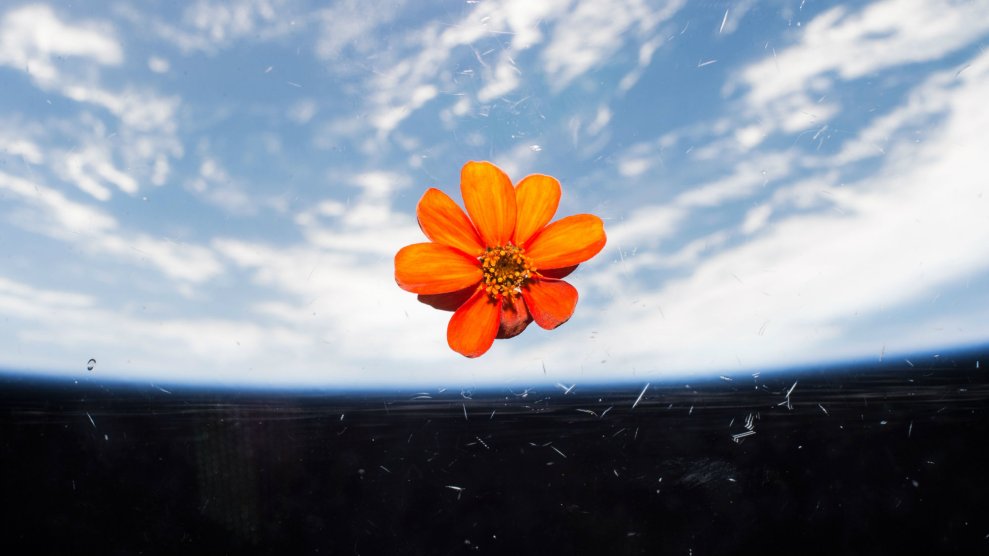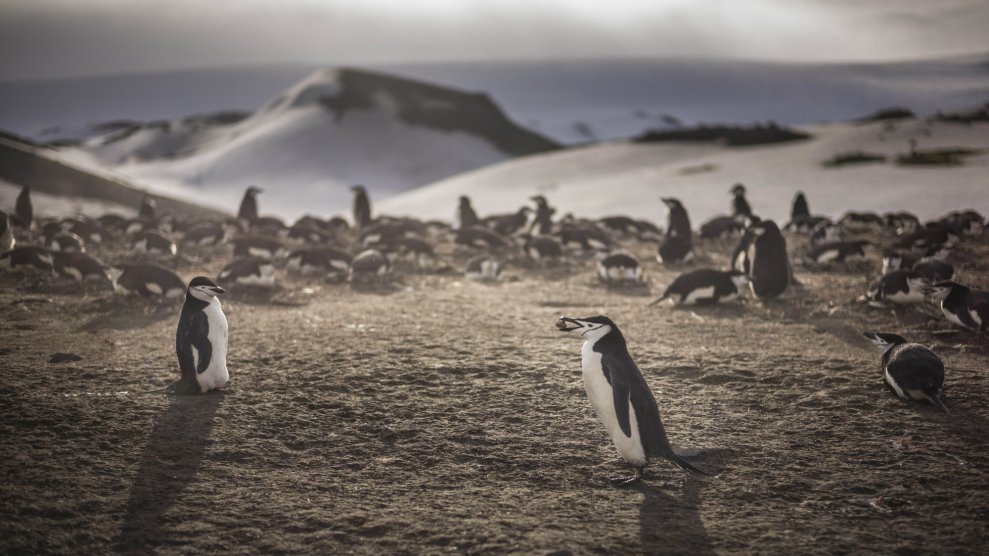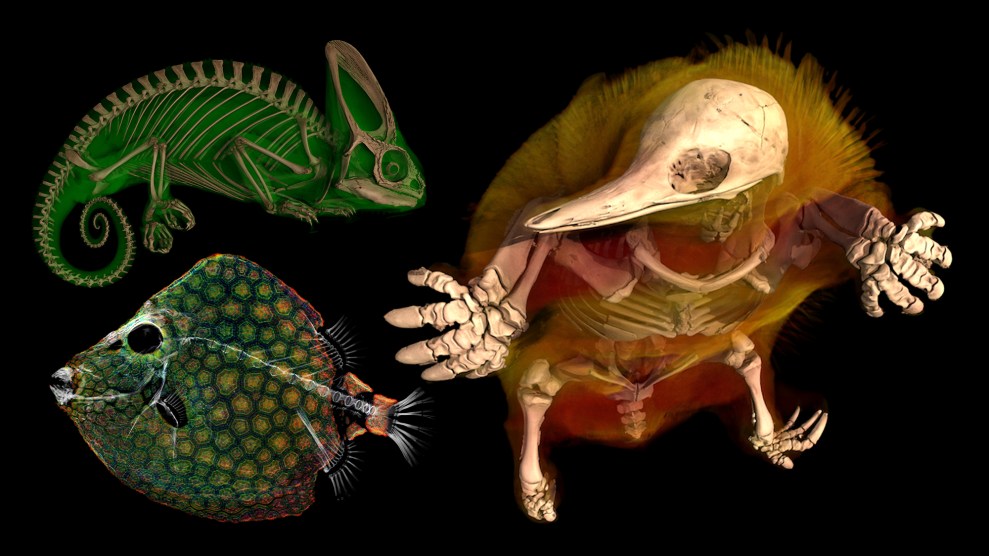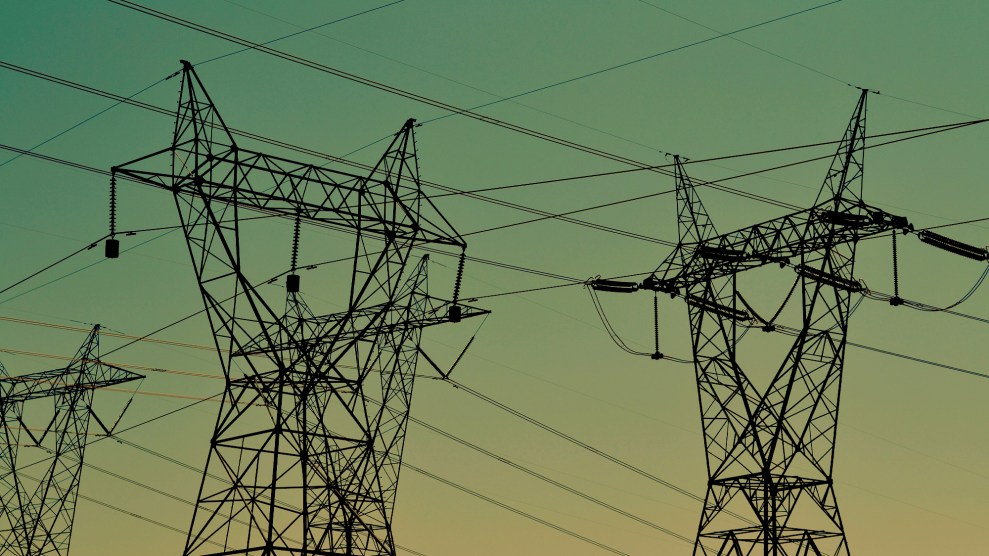
Little zinnias floating freely around the International Space Station.NASA
This story was originally published by Atlas Obscura and is shared here as part of the Climate Desk collaboration.
LaShelle Spencer knew that she was supposed to kill Alfred, but she couldn’t bring herself to do it. Technically his job was done, and Spencer had been instructed to dispose of him and get on with her work. But he was just so small, so fragile—a spindly little lima bean sprouting in a plastic baggie.
Spencer, a food production horticulturalist at NASA, was shut inside a hangar at the Johnson Space Center in Texas, in the Human Exploration Research Analog (HERA) Facility, an experimental setup that models, among other things, crew dynamics and the effects of long-term isolation associated with space travel. The quarters look a bit like a beige yurt set atop a few big septic tanks, and a four-person crew spends several weeks at a time inside the 636-square-foot space. During her “mission” to an asteroid, Spencer passed the time the way an astronaut would, maintaining experiments, working out, and performing drills in the three-story structure. Her tour of duty was 30 days—much less time than it would take a person to reach Mars—but it did not take long for the gray, white, and stainless steel interior to wear on her. “You do start to gravitate toward that green color of home,” she says.
So when the lima bean project—part of an outreach effort with a school—was complete, instead of offing Alfred, Spencer squirreled the sprout away in a spot where cameras wouldn’t catch the crew tending to him. “We loved him,” she says. “We made him a mascot.”
Ever since Soviet cosmonauts germinated seeds on the space station Salyut 1 in the 1970s, space agencies have worked on ways to grow plants off-world. Today, several live aboard the International Space Station (ISS). Interplanetary horticulture is mainly pragmatic, focusing on leafy greens and other vegetables that could eventually sustain crews on long missions. These grow under white, far-red, red, blue, and green LEDs—some of which, to our eyes, appear a cheerful, trippy fuchsia—in carefully calibrated little chambers, some of which are nearly fully automated. Yes, Alfred was technically food, but that’s not why Spencer and her crew spared him.
Tending to plants has psychological benefits, too. NASA describes the veggies aboard the ISS as both a “palatable, nutritious, and safe source of fresh food and a tool to support relaxation and recreation.” Humans who find themselves floating above our world have long felt tenderness toward the plants that are up there with them. The cosmonauts referred to their flax seedlings as their “pets,” American astronaut Scott Kelly carried zinnias with him around the ISS in 2016, and fellow American Donald Pettit—who grew a scrappy sunflower and more—blogged about his off-world botany in 2012 from the perspective of his little zucchini plant. Just before Pettit returned to Earth in a capsule he called his “seed pod,” the astronaut wrote about saying goodbye to the zucchini, taking a final sniff, and blinking back tears. In an unfamiliar place, the plants represent comfort and company.
In a future that might involve extraterrestrial colonization and long, long spaceflight, a new generation of pioneers will probably need to seek creature comforts—things that recall home without compromising too much on the necessary and practical strictures of life beyond our atmosphere. It’s just hard to imagine leaving everything behind. Given that at-home horticulture is booming at the moment, what about houseplants? Keeping crops alive in space is one thing, but the same research could be applied to plants that would do little more than keep people’s spirits aloft.
So which houseplants are best suited to coming along for the ride?
An ideal candidate, first of all, would be a plant that isn’t too thirsty. Of the many factors that frustrate horticulture in microgravity, “The biggest problem we’ve had is water,” says Matt Romeyn, a biologist working on NASA’s vegetable production team at the Kennedy Space Center in Florida. Water doesn’t behave in microgravity the way it does on Earth, where gravity helps it move along to hydrate soil particles and root hairs before excess flows away. On the ISS, it both sticks everywhere and seeps out of containers built to hold it. In microgravity, water forms spheres, which can hang around as “big globs around roots, depriving them of oxygen,” says Chris Wolverton, a plant physiologist at Ohio Wesleyan University whose NASA-funded research focuses on the effects of gravity on plants. Water has slaughtered many green things trying to make a go of it in space. “If you don’t kill the plant by the water glomming onto it and forming a big, wet pocket,” Wolverton says, “you also provide this great environment for fungi, which are notorious for inhabiting space vehicles, and could infest the plant and kill it.”
So the less water to wrangle, the better, both because it must be administered so precisely and because it is such a precious resource to begin with. On the ISS, for instance, much of the water for the plants is repurposed from astronauts’ urine, sweat, and breath. “Then, as the plants give off water vapor through the process of transpiration through their leaves, that water is recondensed in the environment and put back through the system,” says Gioia Massa, a NASA scientist studying plants in microgravity. Thus, Wolverton recommends some kind of succulent, which wouldn’t have major water demands.
The next precious resource in space is attention. How much of it can astronauts afford to spare on shoots and leaves when they’ve got life-or-death stuff to attend to? “If they forget to water it a couple days in a row, we’d want a houseplant to be able to be okay with that,” Spencer says. On that score, she suggests a philodendron. “I have one at home, and it’s neglected often, but it’s still alive.”
A strong contender would also be one that is able to flourish without a light array. The scientists working on crops are currently investigating which wavelengths and ratios of light are ideal for yielding the most nutritious and delicious, or fastest-growing plants, which involves tinkering with arrays of red, blue, green, white, and far-red LEDs. For houseplants, spacefarers would want a less-fussy setup. “Optimally, if you were going to bring a houseplant, something that you’re not going to eat and just serves a purpose for enriching the environment, you would want something that would only be reliant on the ambient environment,” Spencer says. That might mean a simple white LED, or regular cabin lighting, or, if the spacecraft has steady exposure to the Sun, Romeyn says, a plant could be fastened near a window and be nourished by the light that streams in. (Consistent light would not be a possibility on the Moon, however, where 14 bright days are followed by just as many of total darkness.)
In general, houseplants “can tolerate much lower light than what we use for crop production because we’re trying to get plants to grow quickly and be productive and big and make a lot of food,” Massa says. “Houseplants, you kind of want the opposite. You just want it to sort of stay there and look nice, right? You don’t really need it to be big and productive—you just don’t want it to die.” The sweet spot, Massa says, is what’s known as the light compensation point: “Just enough light to keep the plant alive through photosynthesis, but not so much that it just grows like crazy, because then you’re having to repot it or trim it back.”
Pollen and shed petals are no-nos, too, because in microgravity any kind or size of debris can be dangerous, Massa says. These run the risk of clogging filters or getting lodged in someone’s eye. “If it’s fine enough, it could become a respiratory hazard,” Romeyn says, and a forgotten chunk could become a hotspot for microbial growth. Massa says that’s why the NASA horticulture team prefers zinnias, which don’t drop their petals, over petunias, which do.
Extraterrestrial abodes aren’t known for being roomy, and physical space is yet another precious resource in off-world living environments. “The very first thing we look at when we’re looking at new crops is, ‘Does it have a compact growth morphology?’” Romeyn says. The veggie team opts for dwarf varietals, which better fit the habitat (think of pots on a balcony, not beds sprawling across a backyard). Their garden tops out at not much more than a foot, at which point the plants would be butting up against the lights. Massa says that a space houseplant should have a similarly compact profile, which means that popular picks such as peace lilies and dracaena aren’t great options. Spencer suggests aloe vera, a low-maintenance succulent that can stay small for a while. And, in addition to making the cabin feel a little cozier, it can be a salve, soothing skin that is cracking or peeling in the low-humidity environment.
Even after Spencer spared his life, the end was near for Alfred the sprout. His baggie and wet paper towel couldn’t nourish him indefinitely. Despite Spencer’s efforts, he grew too tall and just broke apart. “It was very sad to be the plant person that killed the plant,” she says. But the brief adventure in surreptitious gardening did spark joy in the sterile, cramped environment. Wolverton suspects that a growth chamber plunked down on the Moon could do the same for the first generation of lunar pioneers. He likens it to “visiting a conservatory in the middle of winter”—a warm, welcoming space, and a respite from the cold, dark world outside.















